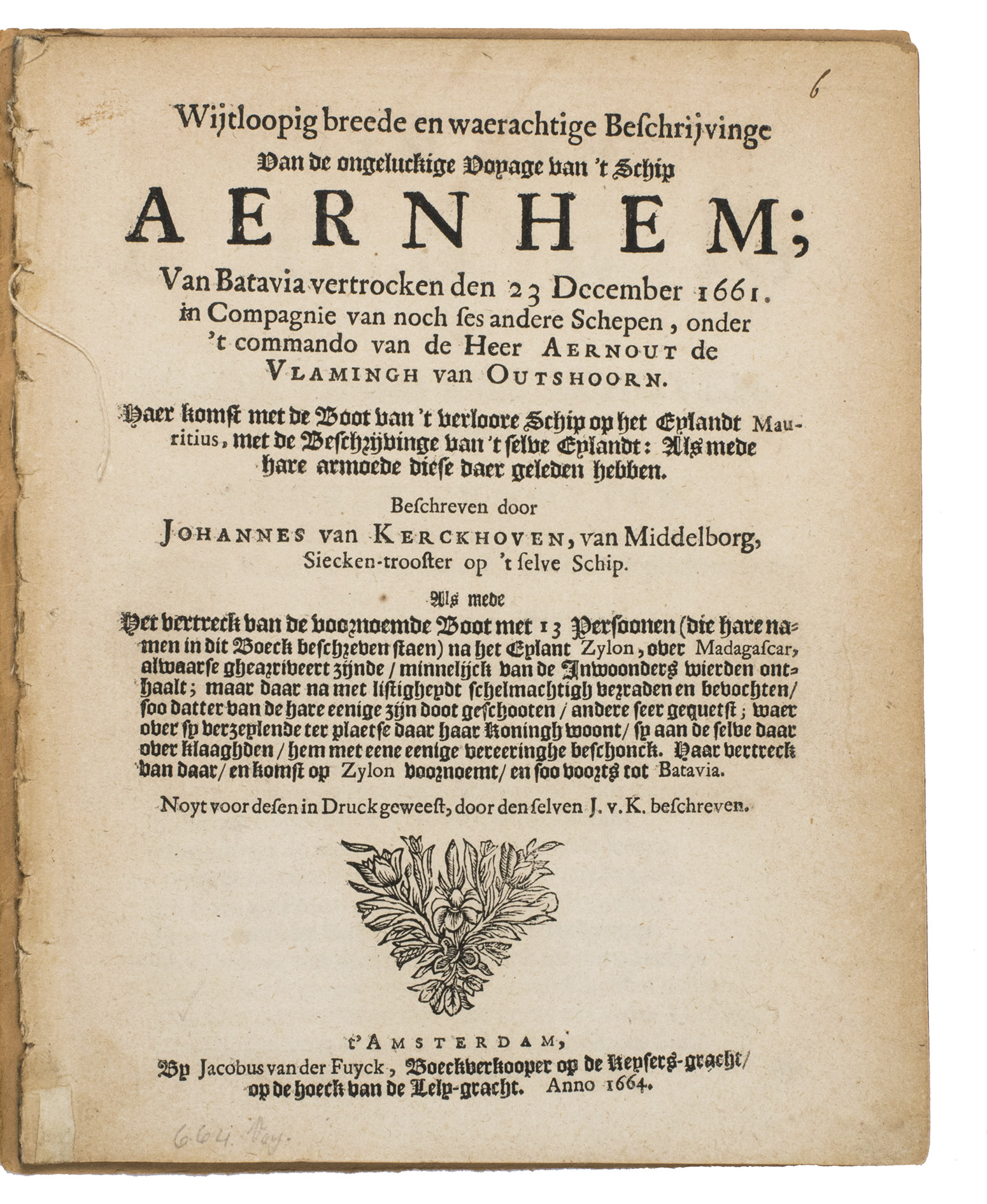KERCKHOVEN, Johannes van [= Simon van den KERKHOVEN].
Wijtloopig breede en waerachtige beschrijvinge van de ongeluckige voyage van t schip Aernhem; van Batavia vertrocken den 23 December 1661 in compagnie van noch ses andere schepen, onder t commando van de heer Aernout de Vlamingh van Outshoorn ...
Amsterdam, Jacobus van der Fuyck, 1664. 4to. With a woodcut vignette on the title page and 2 decorated woodcut initials. Disbound, loosely inserted in 20th-century plain brown paper wrappers. “28” [= 24] pp.
€ 2,500
Rare second edition, under a different title, of an eyewitness report of the dramatic shipwreck of the "Arnhem", a Dutch East Indiaman built in 1654 for the VOC. The report was written by Simon van den Kerkhoven, a religious comforter to the sick ("Siecken-trooster") on board and one of the shipwreck's survivors. The "ziekentrooster" was a religious office within the Dutch Protestant church in the 16th- to 20th centuries. Generally, the person fulfilling its duty was not an official member of the clergy, but when in service of the major trading companies (VOC and WIC) they received a special status which permitted them to perform clerical duties like administering the sacraments.
The account of the shipwreck of the Arnhem was first published in Middelburg by Jacques Fierens in 1663 under the title: Historisch verhael, der wonderlike ende seer zeldsame voor-vallen, den gene bejegent die met het retour-schip Aernhem, van Batavia na het vaderland verreist zyn den 23 decem. 1661. The present second edition claims on the title page that the name of the author is Johannes van Kerckhoven, this appears to be a mistake as both the first edition, the present preface and the signature at the end of the account in the present pamphlet mention Simon van den Kerkhoven. Another difference between the two editions can be found in the preliminaries: the dedication to the directors of the Zeeland chamber of the VOC is replaced by a rhymed preface in Dutch, titled and signed "Aen den leser, door Simon van den Kerckhoven, van Middelburgh; secken-trooster".
On 23 December 1661, the Dutch East Indiaman Arnhem left Batavia in the Dutch East Indies (now Jakarta, Indonesia) and set sail for the Low Countries, together with 6 other ships under the command of the Dutch Admiral Arnold de Vlamingh van Oudtshoorn (1618-1662). In February 1662, on their way to Cape of Good Hope, the fleet was caught in a storm and was scattered. Three ships disappeared without a trace, while the Arnhem ran aground on the Cargados Carajos shoals in the Indian Ocean. Most of the crew managed to leave the ship in a small boat carrying 12 and a larger vessel carrying about 100 both headed for Mauritius, many died on that journey and once back ashore the group further diminished and scattered in their attempt to survive. The surviving crew were able to leave Mauritius in small groups by boarding ships calling at the victualing station on the island. Curiously, the surviving crew members of the Arnhem are now presumed to have been the last people to have seen live dodos.
One of the survivors, Dutch sailor Andries Stokram, published the first report of this shipwreck in May 1663, in which the officers were blamed for the ship's sinking. They were also held responsible for putting men overboard from the lifeboat. Another survivor, the Dutch bookkeeper Johan van Hal, refuted these accusations in his report, which was also published in 1663. In this same year, Van den Kerkhovens report appeared in which he supported the charges of Stokram and held the officers responsible.
The paper wrapper is damaged along the fold of the spine, internally occasionally slightly browned. Otherwise in good condition. Cat. NHSM, p. 188; Knuttel 8912; Landwehr, VOC 421; Petit 3299; Roeper & Wildeman, Reizen op papier, p. 66; STCN 853473501 (6 copies); Tiele, Land- en volkenkunde 1055 note; USTC 1801551 (6 copies, same as STCN); WorldCat 46304175, 223757294, 561184366, 993578567 (8 copies); cf. Knuttel 8760 (1st ed, different title).
Related Subjects:




